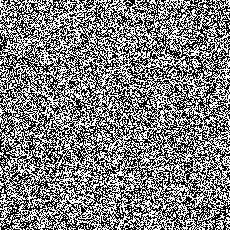In the 17th century, Gottfried Wilhelm Leibniz![]() asked in a letter to one of the Bernoulli brothers if there
might be a pattern in the binary expansion of
asked in a letter to one of the Bernoulli brothers if there
might be a pattern in the binary expansion of ![]() . Three hundred years
later, the question remains. The numbers in the expansion appear to
be completely random. In fact, the most that can be said of any of the
classical mathematical constants is that they are largely non-periodic.
. Three hundred years
later, the question remains. The numbers in the expansion appear to
be completely random. In fact, the most that can be said of any of the
classical mathematical constants is that they are largely non-periodic.
With traditional analysis revealing no patterns of interest, generating
images from the expansions offers intriguing alternatives.
Figures 2 and 3 show 1600 decimal
digits of  and 22/7 respectively, both taken mod 2. The light
pixels are the even digits and the dark one the odd. The digits read
from left to right, top to bottom, like words in a book.
and 22/7 respectively, both taken mod 2. The light
pixels are the even digits and the dark one the odd. The digits read
from left to right, top to bottom, like words in a book.
What does one see? The even and odd digits of ![]() in Figure
2 seem to be distributed randomly, as one would
expect. And the fact that 22/7 (the widely used approximation for
in Figure
2 seem to be distributed randomly, as one would
expect. And the fact that 22/7 (the widely used approximation for
![]() ) is rational appears clearly in Figure 3. Visually
representing randomness is not a new idea; Pickover
[15] and Voelcker [17] have previously examined
the possibility of ``seeing randomness". Rather the intention here
is to identify patterns where none has so far been seen, in this case
in the expansions of irrational numbers.
) is rational appears clearly in Figure 3. Visually
representing randomness is not a new idea; Pickover
[15] and Voelcker [17] have previously examined
the possibility of ``seeing randomness". Rather the intention here
is to identify patterns where none has so far been seen, in this case
in the expansions of irrational numbers.
These are only simple examples but many numbers have structures which are hidden both from simple inspection of the digits and even from standard statistical analysis. Figure 4 shows another rational number 1/65537, this time as a binary expansion, with a period of 65536. Unless graphically represented and with sufficient resolution, the presence of the period might otherwise be missed in then unending string of 0's and 1's.
 |
Figures 5 a) and b)
are based on similar calculations using
1600 terms of the simple continued fractions of ![]() and e respectively.
Continued fractions take the form of
and e respectively.
Continued fractions take the form of

![]()
Presumably this representation of numbers offers a qualitative handle on their character. It tags them in an instantly distinguishable fashion which would be almost impossible to do otherwise.